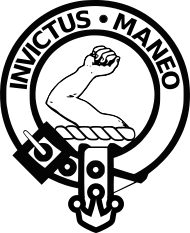|
Clan Armstrong
Clan Armstrong is a Scottish clan of the Scottish Borders.[2] HistoryOrigins of the clanTraditional originsAccording to the legend and tradition, the first of the name Armstrong was Siward Beorn (sword warrior), who was also known as Siward Digry (sword strong arm).[2] He was said to be the last Anglo-Danish Earl of Northumberland and a nephew of King Canute, the Danish king of England who reigned until 1035.[2] Recorded originsThe Armstrong name was common over the whole of Northumbria and the Scottish Borders.[2] The Armstrongs became a powerful and warlike clan in Liddesdale and the Debatable Lands.[2] Historian George Fraser Black lists Adam Armstrong in 1235 as being pardoned for causing the death of another man.[2] By tradition, the Armstrongs followed the cause of Robert the Bruce in the Scottish Wars of Independence, and their recorded relationship with the crown was certainly more straightforwardly loyal in the fourteenth century than in later periods. Alexander Armstrong, second laird of Mangerton was imprisoned and killed by the anti-Bruce conspirator William de Soulis at Hermitage Castle.[3] Gilbert Armstrong, served as steward of the household of David II of Scotland, Master of the Horse to the king, and ambassador to England in 1363.[2] Sir Adam Armstrong was listed in 1374 as one of the knights permitted to travel outside Scotland with the Earl of March and Dunbar, then the principal defender of the Scottish border.[4] Fourteen years later, John Armstrong fought in the army of James, second Earl Douglas at the Battle of Otterburn. In 1398, Alexander, David and Geoffrey Armstrong committed their signatures as 'borowis' for the third Earl of Douglas in pledging to keep the peace on the border.[5] 15th, 16th and 17th centuries In around 1425 John Armstrong, brother of Armstrong of Mangerton in Liddesdale built a strong tower.[2] The Armstrongs were able to raise three thousand horsemen and were said to be at one point in control of the debatable lands.[2] In 1528, Lord Dacre, who was the English Warden of the Marches, attacked the Armstrongs' tower but the Armstrongs retaliated and burned Netherby.[2] The power of the Armstrongs was seen by James V of Scotland as a threat to his own authority.[2] According to tradition, James tricked John Armstrong of Gilnockie to a meeting at Hawick where the king hanged the Armstrong laird without further ado.[2] King James continued his treatment of the Armstrongs when they failed to support him in 1542 at the Battle of Solway Moss.[2] In 1603 the Union of the Crowns brought an official end to the Anglo-Scottish Wars of the Borders.[2] In 1610 the last of the Armstrong lairds was hanged in Edinburgh for leading a raid on Penrith, England.[2] This was followed by a ruthless campaign by the Crown to pacify the Borders.[2] As a result, families were scattered with many of them seeking new homes in Ulster, particularly in County Fermanagh.[2] Armstrong is now amongst the fifty most common names in Ulster.[2] There has been no trace of the Armstrong chiefs since the clan was dispersed in the 17th century.[2] Curiously, despite their tense relationship with the Stewart crown, a number of Armstrongs are recorded as officers in the royalist armies serving Charles I in the Wars of the Three Kingdoms. "Robert Armstrong, Gent, one of His Maties Servants," was buried at St. Olave, York," among a number of royalist casualties.[6] The professional soldier Sir Thomas Armstrong settled in Ireland in 1639, was elected to the Dublin parliament and fought for the crown in the armies of the Earl of Ormonde and the Earl of Inchiquin. He and his sons Thomas and William engaged actively in royalist conspiracies against the Cromwellian Protectorate through the following decade.[7] William ("Christie's Will") Armstrong, perhaps the last of the clan's famous border freebooters, also fought for the crown as a servant of the earl of Traquair.[8] Modern clan historyAmongst the many distinguished Armstrongs are Sir Alexander Armstrong who was an Arctic explorer, and Neil Armstrong who was the first man to walk upon the Moon,[2] taking with him a piece of the Clan Armstrong tartan.[9][10] The Armstrong Baronets are descendants of Gilnockie.[11] Comedian Alexander Armstrong is a descendant.[12] Edwin Howard Armstrong, the inventor of FM Radio, is also a descendant. Although there has been no trace of the Armstrong chiefs since the clan was dispersed in the 17th century, there is a powerful and active clan association and the Clan Armstrong Trust was established in 1978.[2] Castles Castles owned by the Clan Armstrong have included amongst many others:
GaelicIt is unknown if any of the early Armstrongs spoke Gaelic, but Gaelic-derived place names such as Auchenrivock can be found in the Esk River valley, and the language persisted in Galloway, Carrick and the Western Borders well into the seventeenth century, so it is possible.[14] The name of the Armstrong stronghold itself, Gilnockie, is from the Scottish Gaelic Geal Cnocan meaning 'Little White Hill'.[15][16] The Armstrong name is sometimes rendered in Gaelic as follows:
These Gaelic names appear frequently in modern clan literature, but they are neologistic and are rarely used by Gaelic speakers. However, Armstrong has been historically associated with the Ulster Gaelic name, Mac Tréan-Labhraidh, a branch of the Ó Labhradha family. Tréan-Labhradh means strong-speaking but it is thought that the name was misunderstood as meaning strong-arm, and Armstrong was adopted as a convenient Anglicization.[17] Mac Tréan-Labhraidh would translate as Mac Treun-Labhraidh in Scottish Gaelic. Other common associated names include variations on Traynor, Treanor, Trainor, McCreanor, MacCrainor; which all derive from the Irish Gaelic name, Mac Threinfhir, meaning son of the strong man. After the Plantation of Ulster many Armstrongs (mainly those who were Catholic) adopted the Traynor surname. Among the best-known Gaelic-speaking Armstrongs was Dr Robert Armstrong of Perthshire, who compiled an authoritative early Gaelic-English dictionary, published in 1825.[18] See alsoReferences
External links
|
||||||||||||||||||||||||||||

